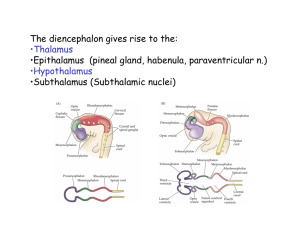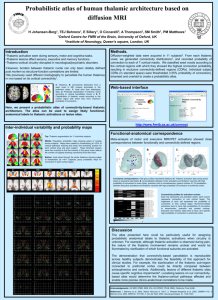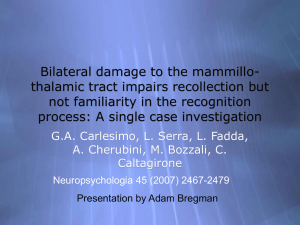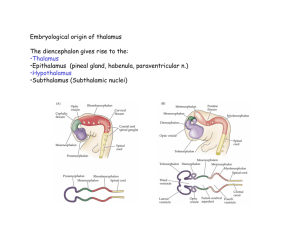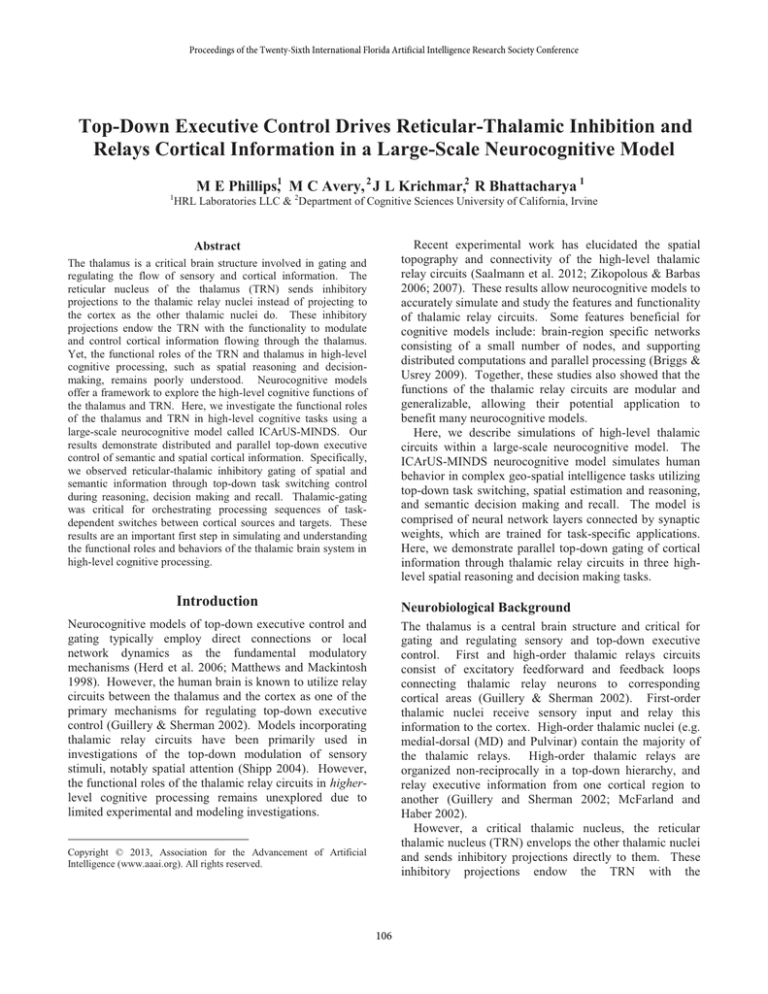
Proceedings of the Twenty-Sixth International Florida Artificial Intelligence Research Society Conference
Top-Down Executive Control Drives Reticular-Thalamic Inhibition and
Relays Cortical Information in a Large-Scale Neurocognitive Model
M E Phillips,1 M C Avery, 2 J L Krichmar,2 R Bhattacharya 1
1
HRL Laboratories LLC & 2Department of Cognitive Sciences University of California, Irvine
Recent experimental work has elucidated the spatial
topography and connectivity of the high-level thalamic
relay circuits (Saalmann et al. 2012; Zikopolous & Barbas
2006; 2007). These results allow neurocognitive models to
accurately simulate and study the features and functionality
of thalamic relay circuits. Some features beneficial for
cognitive models include: brain-region specific networks
consisting of a small number of nodes, and supporting
distributed computations and parallel processing (Briggs &
Usrey 2009). Together, these studies also showed that the
functions of the thalamic relay circuits are modular and
generalizable, allowing their potential application to
benefit many neurocognitive models.
Here, we describe simulations of high-level thalamic
circuits within a large-scale neurocognitive model. The
ICArUS-MINDS neurocognitive model simulates human
behavior in complex geo-spatial intelligence tasks utilizing
top-down task switching, spatial estimation and reasoning,
and semantic decision making and recall. The model is
comprised of neural network layers connected by synaptic
weights, which are trained for task-specific applications.
Here, we demonstrate parallel top-down gating of cortical
information through thalamic relay circuits in three highlevel spatial reasoning and decision making tasks.
Abstract
The thalamus is a critical brain structure involved in gating and
regulating the flow of sensory and cortical information. The
reticular nucleus of the thalamus (TRN) sends inhibitory
projections to the thalamic relay nuclei instead of projecting to
the cortex as the other thalamic nuclei do. These inhibitory
projections endow the TRN with the functionality to modulate
and control cortical information flowing through the thalamus.
Yet, the functional roles of the TRN and thalamus in high-level
cognitive processing, such as spatial reasoning and decisionmaking, remains poorly understood. Neurocognitive models
offer a framework to explore the high-level cognitive functions of
the thalamus and TRN. Here, we investigate the functional roles
of the thalamus and TRN in high-level cognitive tasks using a
large-scale neurocognitive model called ICArUS-MINDS. Our
results demonstrate distributed and parallel top-down executive
control of semantic and spatial cortical information. Specifically,
we observed reticular-thalamic inhibitory gating of spatial and
semantic information through top-down task switching control
during reasoning, decision making and recall. Thalamic-gating
was critical for orchestrating processing sequences of taskdependent switches between cortical sources and targets. These
results are an important first step in simulating and understanding
the functional roles and behaviors of the thalamic brain system in
high-level cognitive processing.
Introduction
Neurobiological Background
Neurocognitive models of top-down executive control and
gating typically employ direct connections or local
network dynamics as the fundamental modulatory
mechanisms (Herd et al. 2006; Matthews and Mackintosh
1998). However, the human brain is known to utilize relay
circuits between the thalamus and the cortex as one of the
primary mechanisms for regulating top-down executive
control (Guillery & Sherman 2002). Models incorporating
thalamic relay circuits have been primarily used in
investigations of the top-down modulation of sensory
stimuli, notably spatial attention (Shipp 2004). However,
the functional roles of the thalamic relay circuits in higherlevel cognitive processing remains unexplored due to
limited experimental and modeling investigations.
The thalamus is a central brain structure and critical for
gating and regulating sensory and top-down executive
control. First and high-order thalamic relays circuits
consist of excitatory feedforward and feedback loops
connecting thalamic relay neurons to corresponding
cortical areas (Guillery & Sherman 2002). First-order
thalamic nuclei receive sensory input and relay this
information to the cortex. High-order thalamic nuclei (e.g.
medial-dorsal (MD) and Pulvinar) contain the majority of
the thalamic relays. High-order thalamic relays are
organized non-reciprocally in a top-down hierarchy, and
relay executive information from one cortical region to
another (Guillery and Sherman 2002; McFarland and
Haber 2002).
However, a critical thalamic nucleus, the reticular
thalamic nucleus (TRN) envelops the other thalamic nuclei
and sends inhibitory projections directly to them. These
inhibitory projections endow the TRN with the
Copyright © 2013, Association for the Advancement of Artificial
Intelligence (www.aaai.org). All rights reserved.
106
down gating of competing inputs to cortical layers within
the large-scale ICArUS-MINDS model (see Fig. 3).
functionality to gate information through first and highorder thalamic relays. This functionality is exploited by
top-down executive control signals from the pre-frontal
cortex (PFC) through the modulation of reticular
inhibition/disinhibition of the thalamic relays (see Fig. 1,
Guillery & Sherman 2002).
Figure 1. Neurobiological circuit architecture of the relay (Thal)
and reticular (TRN) thalamic systems. Two cortical sources (dark
and light) compete for the same cortical target. Executive topdown control from the PFC excites units in the TRN which map
to the thalamic relays of cortical sources. Dis/inhibition of the
thalamic units from the dark/light TRN units (curved lines)
functionally opens/closes the source to target gate (open relays=
solid line, closed relay=dotted line, corticocortical connections=
dashed lines).
Figure 2. Top-down non-topographic modulation of TRN
inhibition to thalamic relay nuclei is indicated by the black box
(modified from Zikopoulos and Barbas 2006).
The model simulates nine major brain regions (PFC,
anterior cingulate cortex (ACC), orbital frontal cortex
(OFC), parietal cortex (PC), temporal cortex (TC), basal
ganglia, hippocampus, brainstem, and the thalamus), and
was constructed to perform six spatial-reasoning and
decision making tasks for the COIN-AHA challenge
problem
in
IARPA’s
ICArUS
program
(COunterINsurgency Abducting Hot-spots of Activity, see
MITRE 2013a,b for a detailed description). Briefly, in
tasks 1-3 spatial reasoning is required to estimate the
likelihood of an attacking group from a spatial pattern of
prior attack locations. In tasks 4-5, the attack probabilities
of the groups must be updated from new intelligence
information, and in task 6 semantic decision making is
required to select amongst intelligence reports. The
ICArUS-MINDS model must perform these cognitive
actions, and switch between these tasks. The overall goal
of the program is to understand human cognitive biases
through neurally-accurate brain models.
Functionally, this means that executive signals can gate
and modulate parallel information channels relayed to
distributed cortical regions via the TRN (see Fig. 2).
Cognitively, executive regions can utilize this mechanism
to provide a top-down contextual (i.e. a learned and taskspecific) modulation of spatial and semantic information
during reasoning and decision making.
Drawing from these results, we created biologicallyrealistic neural models of the thalamus and TRN which
accurately reflect the topography of the input and output
circuit connections.
These component models were
integrated into a large-scale neurocognitive model to
examine the cognitive implications of these neural circuits
and their architecture within a realistic and functioning
network. Here, we show that top-down modulation of the
thalamic relay circuits is critical for orchestrating corticalprocessing sequences of cognitive task switching control
during spatial reasoning and decision-making.
Neural Simulations
The neural simulations used in this work are based on the
Leabra framework in the Emergent simulation software,
described in (O’Reilly & Munakata, 2000) and can be
downloaded
here:
(http://grey.colorado.edu/emergent/index.php/Main_Page).
Materials & Methods
The ICArUS-MINDS Neurocognitive Model
The thalamus and TRN component models were created
to investigate biologically-realistic mechanisms for top-
107
Emergent is a full-featured neural network simulator
descended from PDP and PDP++. Emergent primarily
supports complex, and multi-regional brain models (see
Aisa et al. 2008 for a detailed description).
Results
Neurocognitive Features & Mechanisms
The ICArUS-MINDS model required an architecture to
allow the PFC layer to appropriately gate competing
cortical information paths by directing the appropriate
inputs to relevant layers, and gating irrelevant inputs.
Here, we describe the neural features and mechanisms,
including the projections, size, inputs and outputs of the
relay thalamus and TRN layers, implemented to achieve
functional top-down gating in the ICArUS-MINDS model.
Gating Mechanism: Functional gating is produced by
adjusting the relative weights of the connection strength
between the source and target layers by the thalamus. The
thalamic unit activations causing these adjustments are
trained within the network through supervised error and
Hebbian driven learning of the task-specific control
signals. The inhibitory connection weights in an all-to-all
projection between the TRN and thalamus learn to translate
executive top-down signals into a thalamic activation
pattern which maps to the cortical connection topography
(see Fig. 4). The relative weights of the specified cortical
connections are then adjusted dynamically, as the model
runs. This adjustment can be either facilitating or silencing
(Logothetis et al. 2010). In training, the network began
with random layer activation with a sum of squared-error
of prediction (SSE) of 0.144, after 20 epochs of training;
the network reached an SSE of 0.007.
Network Inputs & Outputs: As depicted in Figure 4, the
thalamus and TRN layers receive top-down excitatory
control signals from PFCTaskNum layer (a task-specific
control signal: 1-6). The PFCTaskPhase layer sends
excitatory input to TRN units that specify a sub-phase
within a task (see Applications of the Cognitive
Architecture: Application 3). This non-topographic topdown control signal results from layer 5 pyramidal neurons
in the PFC distributing projections widely to both PFC and
non-PFC regions of the TRN (see box in Fig. 2,
Zikopoulos & Barbas 2006; 2007). These executive
signals convey a task-specific context for relative-weight
connection strength adjustments. Under control by the
PFC layer, the thalamus and TRN layers provide a
functional gate for inputs to the Probability and Distance
layers in the PC and EC_in layer in the hippocampal
system (the Probability layer stores an online estimate of a
group’s attack likelihood, and Distance contains an
estimate of the spatial separation between a group and an
attack location). Inputs to these target layers are mutually
exclusive (except for the EC_in during task 6, where two
inputs occur during two separate hippocampal-phases, see
application 3 and Fig. 4).
Connection Topography: The cortical projections of the
thalamic relay circuits are organized with a topography
reflecting the thalamocortical projections to DistanceFly,
DistanceWalk, PCProbsOut and VIPHidden in the PC and
Figure 3. The nine brain region ICArUS-MINDS neurocognitive
model (thalamus & TRN components are highlighted by the box).
Within the Emergent simulator, neurons summate
excitatory, inhibitory, and leak conductances into a
membrane potential that is thresholded and passed through
a sigmoidal function to produce rate coded outputs. Layers
in the model use ensembles of excitatory neurons with kwinner-take-all inhibition to simulate both populations
efficiently. Learning is accomplished through a mix of
Hebbian and error driven learning that incorporates an
adaptive threshold for firing. The model operates in 2
phases: a minus phase where only input stimuli are
clamped onto input units (with no synaptic modification),
and a plus phase where both input and output units are
clamped (i.e. allowed to fire).
Differential neural
activations from the 2 phases drive error driven learning.
Connections between layers can follow a variety of
topologies, including one-to-one, full, and geometric to
create specific receptive fields. Figure 4 shows how the
general architecture from Figure 1 was adapted in the
ICArUS-MINDS model to accomplish three applications
of task switching control, spatial reasoning, and semantic
decision making and recall (see Applications of the
Cognitive Architecture).
108
ITINT, ITRule, and Group_ID in the TC (See Fig. 4 and
Applications of the Cognitive Architecture for a detailed
description of these layers and their cognitive functions,
Behrens et al 2003; Schmahmann & Pandya 2004). The
TRN layer is organized with a local topography that
reflects the top-down inputs from PFCTaskNum and
PFCTaskPhase. This mixed PFC/PC topography in the
thalamic system is seen in high-order associational
thalamic nuclei (such as MD and the Pulvinar, Guillery &
Sherman 2002; Zikopoulos & Barbas 2006; 2007). This
input/output architecture of the thalamus and TRN is
believed to be a central mechanism for top-down executive
control (Zikopoulos & Barbas 2006).
Network Size: The thalamic layers consist of a seven unit
(rate-code based neuron ensembles) relay thalamus and an
eight unit TRN, each of which maps to a functional
domain, and internal to each is a population of neurons
(see Fig. 4). The extra unit in the TRN is required for taskphase switching described in Application 3. In addition,
these layers maintain a realistic ratio of thalamic to cortical
neurons in ICArUS-MINDS (~1:160 Williams & Rakic
1988; O’Kusky & Colonnier 1982), while maintaining a
large information bandwidth between cortical areas.
Cognitive Architecture Comparison: The ICArUSMINDS model, created to simulate neural structures and
their functions, shares common features with many
cognitive-architectures such as working, semantic, and
episodic memory systems, a biased-competition based
attentional system, as well as reward, error, and Hebbian
learning systems (see Samsonovich 2012, BICA table for a
detailed comparison with other cognitive architectures).
Numerous differences also exist. For example, ACT-R has
used a recency code in episodic memory for a similar task
switching behavior (Altmann & Grey 2008).
Applications of the Cognitive Architecture
This section details three applications of the thalamus and
TRN models fully-integrated into the ICArUS-MINDS
neurocognitive model for the COIN-AHA challenge
problem. This complex geo-spatial intelligence problem
requires task switching control in all tasks, spatial
reasoning in task 1-3, and decision making in tasks 4-6
(see MITRE 2012a for a full description). In COIN-AHA,
the model is required to estimate the likelihood of
attacking groups from a spatial pattern of attack locations
and intelligence reports. Here, we demonstrate that the
thalamus and TRN models orchestrated multiple cortical
sources and processing sequences to their cortical targets
through top-down task switching control in three
applications of high-level semantic decision making and
spatial reasoning.
These applications allow the
architecture to use the same mechanism for top-down task
switching control to gate cortical information based on task
demands, and mix in recalled information for additional
processing.
Neurocognitive Model Performance
The ICArUS-MINDS neurocognitive model performance
was compared to the average behavior of 103 humans in
probability prediction (S1) and resource allocation (S2).
The model matched human behavior well in tasks 1,3,5,
and 6 (0=perfect match, 1=poor match, see Table 1 and
MITRE 2013a for details).
Task 1
Task 2
Task 3
Task 4
S1 (H-M)
-0.0118
Task 5
Task 6
0.1208
0.0477
0.1180
0.0523
0.0639
S2 (H-M)
-0.0160
0.1256
0.1379
0.0359
-0.0147
0.0326
Figure 4. Multi-phase top-down gating of high-order thalamic
relays during decision making. A. ITINT and ITRule project, via
thalamic relays, to the EC_in layer. The TRN task 6a unit gates
ITRule (solid line), the task 6b unit gates ITINT (dashed line). B.
Examples of the circuit during phases A and B of task 6 in the
ICArUS-MINDS model. Dark filled/striped units are active–open
gates, light filled units are inactive–closed gates (Connections: 1one-to-one relay inputs, 2-one-to-one & one-to-all top-down
executive modulation, 3-TRN inhibitory projections (learned), 4one-to-one relay targets, black lines with circles=inhibitory
connections, light lines with arrows=excitatory connections).
Table 1. ICArUS-MINDS performance across all COINAHA tasks. S1 measures the model’s match to human
reported probably values with respect to the Bayesian
probability distribution (Human –Model probabilities). S2
measures the model’s match to human’s resource allocation
behavior (Human –Model Resource allocation; see MITRE
2013a, b for tasks and score details).
109
thalamus adjust the relative weights between DistanceFly
and DistanceWalk to the Distance layer respectively.
Without the TRN and thalamus layers, distance
information cannot reach the PC and probability estimates
can only be based on numerosity and radius.
Application 3—Semantic Decision Making & Recall: In
the final application of the thalamic gating circuit, multiphasic top-down control is applied to the recollection of
semantic knowledge and in the decisional selection of
intelligence reports. The hippocampal system is used in
ICArUS-MINDS to recall and select the appropriate
intelligence report to distinguish between groups. As
depicted in Figure 4A, three TC sources (GroupID, ITINT
and ITRule) are gated into the Entorhinal cortex (EC_in,
the target layer), by the thalamus. In phase A of task 6 the
intelligence rule (ITRule – a measure of the highest
probability groups) is gated into EC_in to recall the
semantic information contained within the different
intelligence reports. Then, in phase B of task 6, the
intelligence value (ITINT – a measure of semantic content)
is gated into EC_in in order to select the appropriate
intelligence report based on ITRule (see Fig. 4). GroupID
is used to disambiguate attacking groups in tasks 1-3 when
ICArUS-MINDS evaluates the probabilities for each group
individually. As in the other two applications, the
connection weights are learned, and PFCTaskNum and
PFCTaskPhase provide top-down excitatory inputs to the
TRN which inhibit/disinhibit the corresponding thalamic
units. Without the TRN and thalamus networks, semantic
recall is hindered and the model can only make random
guesses to receive intelligence reports.
Application 1—Task Switching Control: The PFC
provides executive top down control to direct the correct
cortical information source to the correct cortical target
region. This process is driven by task demands, and is
mechanistically achieved through inhibition/disinhibition
of the Thal layer by the TRN. The Probability layer within
the PC uses two distinct inputs to estimate the probability
of an attack (VIPHidden and PCProbsOut). VIPHidden is
used in spatial reasoning to compute group attack
probabilities from spatial parameters such as distance. In
tasks 4-6, prior group probability values are given as inputs
to the model and must be updated by additional
intelligence information stored in PCProbsOut (Fig. 4).
Finer grained phasic task switching control is achieved
in task 4 and 6 by using the 4a & 4b (6a & 6b) units of the
TRN. This intra-task phasic switching is required during
semantic recall and selection (see Application 3). The
PFCTaskPhase layer provides an additional top-down
excitatory input required to break the tie of equal excitation
from PFCTaskNum between the two task phases. This
additional input raises the correct unit above its activation
threshold. The winner-take-all unit value of the TRN layer
is manually set to one to ensure that only a single set of
task and phase-specific connections are active at a time.
The thalamic units learn the correct relative-weight
connection state (on/off) during network training as a
function of the top-down executive signals of task and
phase context (i.e. PFCTaskNum and PFCTaskPhase). For
example, thalamic units 3 and 4 (counting from the
bottom) adjust the relative weight connection strength
between VIPHidden and PCProbsOut and the Probability
layer respectively in Task 4. Without the TRN and
thalamus layers updated probability information from
VIPHidden does not reach the Probability layer in the PC.
Any probability estimates after lesioning are sampled from
a uniform probability distributed across all four options
(25% each, after normalization).
Application 2—Spatial Reasoning: In the second
application of the top-down thalamic gating circuit, two
different spatial estimates of the distance between attack
and group locations are gated into the Distance layer.
DistanceFly is a 2D spatial representation of attack
locations; DistanceWalk is a 1D road structure of attack
locations. The Distance layer in the PC must receive input
from only one of the layers to estimate the correct taskspecific distance. DistanceFly is used in tasks 1 and 2,
where Euclidean distances are estimated from the 2D space
of attacks. In tasks 3-6, roads are present in the spatial
pattern of attacks, and the distance from attack location to
the group must be calculated along winding road segments
using DistanceWalk. PFCTaskNum and PFCTaskPhase
provide the task-specific top-down excitatory contextual
inputs to the TRN which inhibit the corresponding units in
the thalamus. The connection weights are learned as
described in Application 1. The 1st and 2nd units in the
Discussion
We have demonstrated a biologically-accurate model of
the thalamus and TRN that can functionally gate cortical
information in a neurocognitive model of task switching
control, spatial reasoning and semantic recall and decision
making. Our model accomplished top-down executive
control of high-order thalamic relay circuits through TRNmediated inhibitory gating. The thalamic and TRN
systems were an integral component of the ICArUSMINDS neurocognitive model. This model accurately
simulated many interacting brain systems and was an ideal
framework to explore a neural model of top-down task
switching control using the reticular-thalamic system
(MITRE 2013a). The neural mechanisms of executive
control of distributed, parallel cortical computations were
critical for cognitive task sequencing of spatial reasoning,
semantic recall, and decision making in the ICArUSMINDS model.
This cognitive functionality was accomplished in a
network with a large information bandwidth, and of
biologically-accurate size and connectivity. The thalamic
and TRN networks were essential to orchestrate task-
110
specific top-down control of cortical processing sequences
in the PC and EC during high-level semantic decision
making and spatial reasoning. Corticocortical connections,
offer an alternative mechanism for this behavior (Sherman
and Guillery 2011). However, the thalamic architecture
described here can be easily adapted to many cognitive
models requiring distributed executive control of parallel
information channels from a small network.
This
architecture can also scale rapidly for many different tasks,
requiring only one additional thalamic unit for each
additional switch. Furthermore, this model provides an
opportunity to examine the underlying causes of behavioral
deficits from differences in cortical information processing
due to PFC dysfunction in executive control.
One alternate theory suggests that top-down executive
gating may be accomplished through spike synchrony or
gamma oscillations in the brain (Minlebaev et al. 2011).
Although the circuits presented here are functional analogs
of the dynamical spiking mechanisms, our rate coding
approach has a limited ability to capture spiking dynamics.
Yet, a rate coding modeling approach has several
advantages, such as binding and sequence maintenance
(O’Reilly et al. 2003). Further work is required to contrast
dynamical spiking with rate coding mechanisms, extend
the role of the thalamus in other cognitive tasks, and to
explore the role of attention and adaptation in regulating
top-down control.
Mathews, A., & Mackintosh, B. (1998). A cognitive model of selective
processing in anxiety. Cognitive Therapy and Research, 22(6), 539-560.
References
Sherman, S. M., & Guillery, R. W. (2011). Distinct functions for direct
and
transthalamic
corticocortical
connections.
Journal
of
neurophysiology, 106(3), 1068-1077.
McFarland NR, Haber SN. Thalamic relay nuclei of the basal ganglia
form both reciprocal and nonreciprocal cortical connections, linking
multiple frontal cortical areas. J Neurosci. 2002 Sep 15;22(18):8117-32.
Minlebaev, M., Colonnese, M., Tsintsadze, T., Sirota, A., & Khazipov, R.
(2011). Early gamma oscillations synchronize developing thalamus and
cortex. Science, 334(6053), 226-229.
MITRE. IARPA’s ICArUS Program: Phase 1 Challenge Problem Design
and Test Specification. In Press. 2013a
MITRE. A Computational Basis for ICArUS Challenge Problem Design.
In Press. 2013b
O'Kusky J and Colonnier M. A laminar analysis of the number of
neurons, glia, and synapses in the adult cortex (area 17) of adult macaque
monkeys. J Comp Neurol. 1982 Sep 20;210(3):278-90.
O’Reilly, R. C., Busby, R. S., & Soto, R. (2003). Three forms of binding
and their neural substrates: Alternatives to temporal synchrony. The unity
of consciousness: Binding, integration, and dissociation, 168-192.
O'Reilly, R. C., & Munakata, Y. (2000). Computational explorations in
cognitive neuroscience: Understanding the mind by simulating the brain.
MIT press.
Saalmann, Y. B., Pinsk, M. A., Wang, L., Li, X., & Kastner, S. (2012).
The pulvinar regulates information transmission between cortical areas
based on attention demands. Science, 337(6095), 753-756.
Samsonovich A. BICA Society: CogArch Comparison Table (2012).
http://bicasociety.org/cogarch/architectures.pdf
Schmahmann, J. D., & Pandya, D. N. (2004). Anatomical investigation of
projections from thalamus to posterior parietal cortex in the rhesus
monkey: a WGA HRP and fluorescent tracer study. The Journal of
comparative neurology, 295(2), 299-326.
Aisa, B., Mingus, B., & O’Reilly, R. (2008). The emergent neural
modeling system. Neural networks, 21(8), 1146-1152.
Shipp, S. (2004). The brain circuitry of attention. network, 5, 59.
Altmann, E. M., & Gray, W. D. (2008). An integrated model of cognitive
control in task switching. Psychological review, 115(3), 602.
Williams RW, Rakic P. Elimination of neurons from the rhesus monkey's
lateral geniculate nucleus during development. J Comp Neurol. 1988 Jun
15;272(3):424-36.
Behrens, T. E. J., Johansen-Berg, H., Woolrich, M. W., Smith, S. M.,
Wheeler-Kingshott, C. A. M., Boulby, P. A., ... & Matthews, P. M.
(2003). Non-invasive mapping of connections between human thalamus
and cortex using diffusion imaging. Nature neuroscience, 6(7), 750-757.
Zikopoulos B, Barbas H. Circuits for multisensory integration and
attentional modulation through the prefrontal cortex and the thalamic
reticular nucleus in primates. Rev Neurosci. 2007;18(6):417-38.
Briggs, F., & Usrey, W. M. (2009). Parallel processing in the
corticogeniculate pathway of the macaque monkey. Neuron, 62(1), 135.
Zikopoulos B, Barbas H. Prefrontal projections to the thalamic reticular
nucleus form a unique circuit for attentional mechanisms. J Neurosci.
2006 Jul 12;26(28):7348-61.
Engelmore, R., and Morgan, A. eds. 1986. Blackboard Systems. Reading,
Mass.: Addison-Wesley.
Guillery RW, Sherman SM. Thalamic relay functions and their role in
corticocortical communication: generalizations from the visual system.
Neuron. 2002 Jan 17;33(2):163-75. Review.
Acknowledgements
Supported by the Intelligence Advanced Research Projects
Activity (IARPA) via Department of the Interior (DOI)
contract number D10PC20021. The U.S. Government is
authorized to reproduce and distribute reprints for
Governmental purposes notwithstanding any copyright
annotation thereon. The views and conclusions contained
hereon are those of the authors and should not be
interpreted as necessarily representing the official policies
or endorsements, either expressed or implied, of IARPA,
DOI, or the U.S. Government.
Herd, S. A., Banich, M. T., & O'reilly, R. C. (2006). Neural mechanisms
of cognitive control: An integrative model of Stroop task performance and
fMRI data. Journal of Cognitive Neuroscience, 18(1), 22-32.
Jones EG. The Thalamus. New York: Plenum 1985.
Kara P, Pezaris JS, Yurgenson S, Reid RC. The spatial receptive field of
thalamic inputs to single cortical simple cells revealed by the interaction
of visual and electrical stimulation. Proc Natl Acad Sci U S A. 2002 Dec
10;99(25):16261-6. Epub 2002 Dec 2.
Logothetis NK, Augath M, Murayama Y, Rauch A, Sultan F, Goense J,
Oeltermann A, Merkle H. The effects of electrical microstimulation on
cortical signal propagation. Nat Neurosci. 2010 Oct;13(10):1283-91.
Epub 2010 Sep 5.
111


